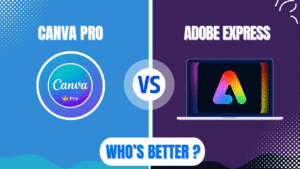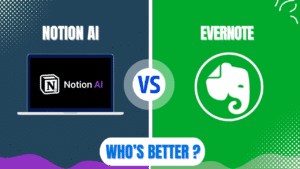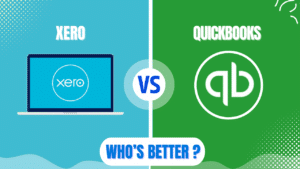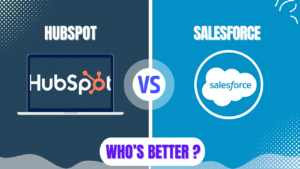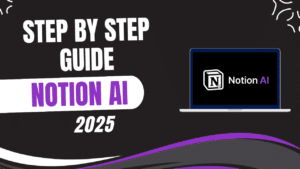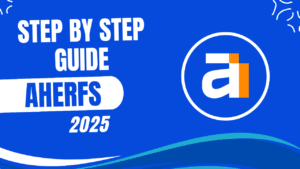ClickUp is the better project management tool in 2025. It offers more features at a lower price point than Monday.com, making it the clear winner for most teams. While Monday.com has a more intuitive interface, ClickUp’s comprehensive functionality, extensive customization options, and superior automation capabilities deliver better overall value and productivity benefits.
How These Tools Compare Head-to-Head
Both Monday.com and ClickUp offer robust project management features, but they serve different needs. Monday.com excels at visual workflow management with an easy learning curve. ClickUp provides deeper functionality with more advanced features at every price tier.
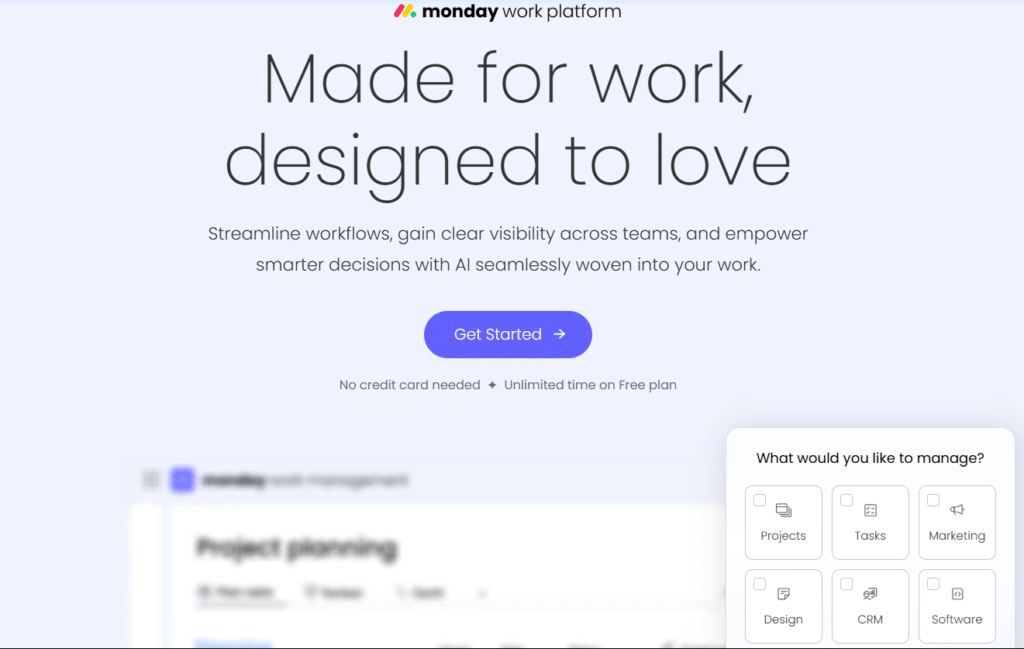
Your choice depends on your team’s specific requirements. Teams wanting simplicity and visual appeal might prefer Monday.com. Organizations needing comprehensive functionality at a better price will find ClickUp more suitable.
Here’s a direct comparison of what matters most:
- Price: ClickUp wins with more features at lower price points across all tiers
- Ease of Use: Monday.com has a slight edge with its intuitive interface Feature Set: ClickUp offers more comprehensive functionality
- Customization: ClickUp provides greater flexibility for tailoring workflows
- Integrations: Both offer extensive integration options, but ClickUp has more native connections
- Reporting: ClickUp delivers more advanced reporting capabilities
- Automation: ClickUp’s automation features are more powerful and accessible at lower tiers
Let’s break down both platforms in detail so you can make the right choice for your team.
Comprehensive Comparison Table
| Feature | Monday.com | ClickUp |
|---|---|---|
| Starting Price | $10/user/month | $7/user/month |
| Free Plan | Limited to 2 users | Unlimited users with restrictions |
| User Interface | Highly visual, intuitive | Feature-rich, slightly steeper learning curve |
| Customization | Good, with board-based focus | Excellent, with multiple view options |
| Task Management | Strong visual task boards | Comprehensive with task dependencies |
| Time Tracking | Available on Standard plan | Available on free plan |
| Automations | Limited on lower tiers | Extensive even on lower-priced plans |
| Reporting | Good visualization options | Advanced with customizable dashboards |
| Integration Count | 200+ | 1,000+ |
| Mobile Experience | Well-designed, responsive | Feature-rich but occasionally cluttered |
| Best For | Teams wanting visual simplicity | Organizations needing comprehensive features |
Pricing Plans Breakdown
Monday.com Pricing
| Plan | Price | Key Features |
|---|---|---|
| Free | $0 | Up to 2 users, basic task boards, 500MB storage |
| Basic | $10/user/month | Unlimited free viewers, 5GB storage |
| Standard | $12/user/month | Timeline view, calendar view, advanced automations (250/month) |
| Pro | $20/user/month | Time tracking, formula columns, private boards, 10GB storage |
| Enterprise | Custom pricing | Advanced reporting, enterprise-level security, unlimited storage |
ClickUp Pricing
| Plan | Price | Key Features |
|---|---|---|
| Free Forever | $0 | Unlimited tasks, 100MB storage, unlimited users with restrictions |
| Unlimited | $7/user/month | Unlimited storage, integrations, Gantt charts |
| Business | $12/user/month | Advanced automations, custom fields, time tracking |
| Enterprise | Custom pricing | White labeling, enterprise API, dedicated success manager |
| Business Plus | $19/user/month | Team sharing, increased automations, subtasks in multiple lists |
User Interface & Experience
Monday.com Interface
Monday.com built its reputation on visual appeal and ease of use. The colorful, board-based interface makes project tracking intuitive and engaging. Even non-technical users can navigate the platform effectively after minimal training.
The platform uses a spreadsheet-like grid system with rows representing tasks and columns showing different attributes. Color coding provides immediate status updates at a glance.
New users often mention how quickly they can set up workflows. The learning curve is gentle, making Monday.com particularly strong for teams with varying technical abilities.
However, this simplicity comes with limitations. Complex projects with numerous dependencies and subtasks can become unwieldy as you scale.
ClickUp Interface
ClickUp offers a more comprehensive interface with multiple ways to view your work. While slightly more complex initially, it provides greater versatility once mastered.
The platform includes 15+ view options including list, board, calendar, Gantt chart, and mind map views. This flexibility allows team members to interact with projects in ways that best suit their roles.
ClickUp’s interface contains more features visible at once, which can feel overwhelming to new users. However, this design choice puts powerful tools within immediate reach rather than buried in menus.
Many users report that after the initial learning period, ClickUp’s interface actually saves time by reducing the need to switch between different sections.
Task Management Capabilities
Monday.com Task Management
Monday.com excels at visual task organization. Its board structure makes it easy to:
- Track task status through color-coded elements
- Assign tasks to team members
- Set priorities and deadlines
- Add comments and file attachments
The platform handles basic dependencies, but complex task relationships become challenging to manage as projects grow. Subtasks exist but have limitations compared to main tasks.
Monday.com’s column structure lets you customize task attributes, though advanced features like formulas are restricted to higher-priced plans.
ClickUp Task Management
ClickUp takes task management several steps further with:
- Unlimited nested subtasks for breaking down complex work
- Multiple assignees per task
- Task dependencies with relationship visualization
- Custom statuses tailored to each workflow
- Task templates for recurring work
The platform excels at handling tasks with multiple stages and dependencies. Its “Everything view” helps users manage work across multiple projects simultaneously.
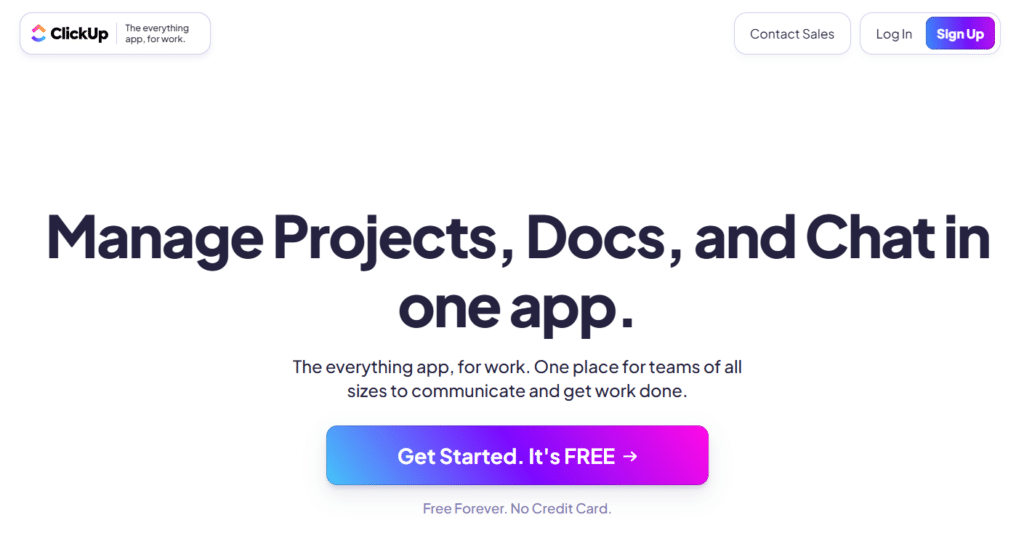
ClickUp also offers more robust task prioritization tools, allowing teams to adjust task importance based on multiple factors beyond simple high/medium/low designations.
Workflow Automation Features
Monday.com Automation
Monday.com includes automation capabilities, but with significant restrictions on lower-priced tiers:
- Basic plan: No automations
- Standard plan: 250 automation runs per month
- Pro plan: 25,000 automation runs per month
The automation builder uses a recipe-based approach with trigger-action pairs. Common automations include:
- Status change notifications
- Due date reminders
- Task assignments based on status changes
- Moving items between boards based on criteria
While functional, Monday.com’s automation engine lacks some advanced conditional logic capabilities found in ClickUp.
ClickUp Automation
ClickUp offers a more generous automation allowance across all paid plans:
- Unlimited plan: 100 automation runs per month
- Business plan: 10,000 automation runs per month
- Business Plus: 50,000 automation runs per month
Beyond quantity, ClickUp’s automation capabilities are more sophisticated:
- Multi-step automation sequences
- Conditional branching logic
- Automation across projects and workspaces
- Custom automation triggers
The platform also includes AI-assisted automation suggestions based on your workflow patterns. This helps teams discover efficiency opportunities they might otherwise miss.
Collaboration Features
Monday.com Collaboration
Monday.com facilitates team collaboration through:
- In-context comments and @mentions
- File sharing and document collaboration
- Activity tracking to see who changed what
- Shared boards and dashboards
- Team workload views
The platform excels at making information visible to everyone involved. Its update section works as a mini communication hub for each task.
One standout feature is “Monday workdocs,” which allows teams to create collaborative documents directly in the platform. This reduces switching between document tools and project management.
ClickUp Collaboration
ClickUp matches most of Monday.com’s collaboration features while adding:
- Real-time document collaboration with cursor tracking
- Assigned comments that convert to trackable tasks
- Chat view for team discussions
- Clip for screen recording and sharing
- Mind maps for collaborative brainstorming
ClickUp’s comment threads are particularly well-implemented, allowing for focused discussions that don’t get lost in project updates. The platform also includes robust permission settings for controlling who can view or edit different elements.
Both platforms support team communication well, but ClickUp offers more ways for teams to collaborate on diverse types of work.
Reporting & Analytics
Monday.com Reporting
Monday.com provides solid reporting capabilities through:
- Visual dashboards with charts and graphs
- High-level project status reports
- Team workload analysis
- Time tracking reports (Pro plan and above)
Reports are visually appealing and easy to interpret. The dashboard widgets provide flexibility in how data is presented.
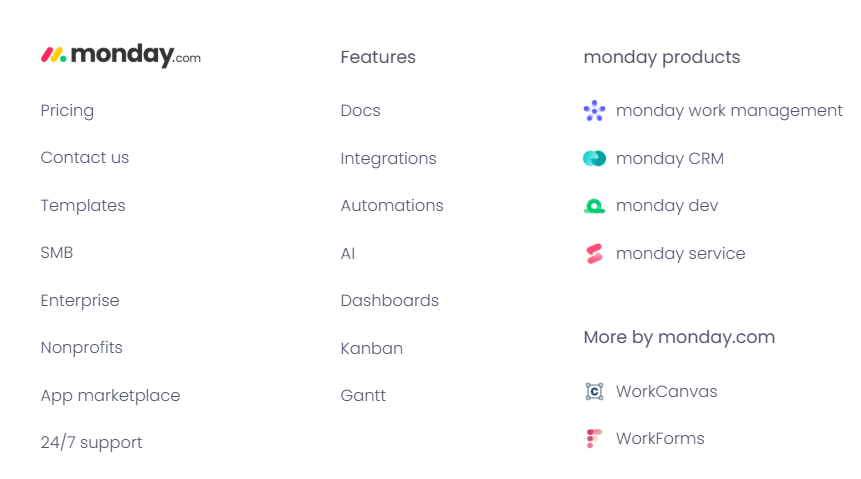
However, advanced reporting features require higher-tier plans, and some users report limitations in creating highly customized reports that combine data from multiple boards.
ClickUp Reporting
ClickUp offers more comprehensive reporting tools:
- Customizable dashboards with 50+ widgets
- Workload view with capacity planning
- Sprint reports for agile teams
- Time tracking with billable rates and estimates
- Global reporting across all workspaces
The platform allows deeper data analysis, especially across multiple projects or departments. Reports can be scheduled and automatically shared with stakeholders.
ClickUp’s reporting structure makes it easier to create executive-level views while maintaining detailed operational reports for team use.
Integration Capabilities
Monday.com Integrations
Monday.com connects with approximately 200+ popular tools including:
- Microsoft Office and Google Workspace
- Slack and Teams for communication
- Financial tools like QuickBooks and NetSuite
- CRM platforms like Salesforce and HubSpot
- Development tools like GitHub and Jira
While the integration count is substantial, some connections require higher-tier plans. The platform also offers a strong API for custom integrations.
ClickUp Integrations
ClickUp boasts over 1,000 integrations, with most available even on lower-priced plans:
- All major productivity suites
- Communication tools
- CRM and marketing platforms
- Development and design tools
- Time tracking and finance applications
Beyond quantity, ClickUp’s integrations often feature deeper functionality. For example, its Slack integration allows for more actions directly from the communication platform without switching contexts.
ClickUp also includes Zapier integration on all paid plans, dramatically expanding connection possibilities.
Mobile Experience
Monday.com Mobile
Monday.com offers a well-designed mobile app for iOS and Android that maintains most core functionality:
- Task viewing and status updates
- File attachments and comments
- Basic board navigation
- Notifications and updates
The app preserves the visual appeal of the desktop version while simplifying the interface for smaller screens. Users report good performance and reliability.
Some limitations exist for complex views and advanced features, but the essentials work well for on-the-go updates.
ClickUp Mobile
ClickUp’s mobile app packs more functionality:
- Multiple view options (list, board, calendar)
- Task creation with full attributes
- Document editing capabilities
- Time tracking
- Voice notes and dictation
While feature-rich, some users find the mobile interface occasionally cluttered. The app attempts to include most desktop functionality, which can impact simplicity.
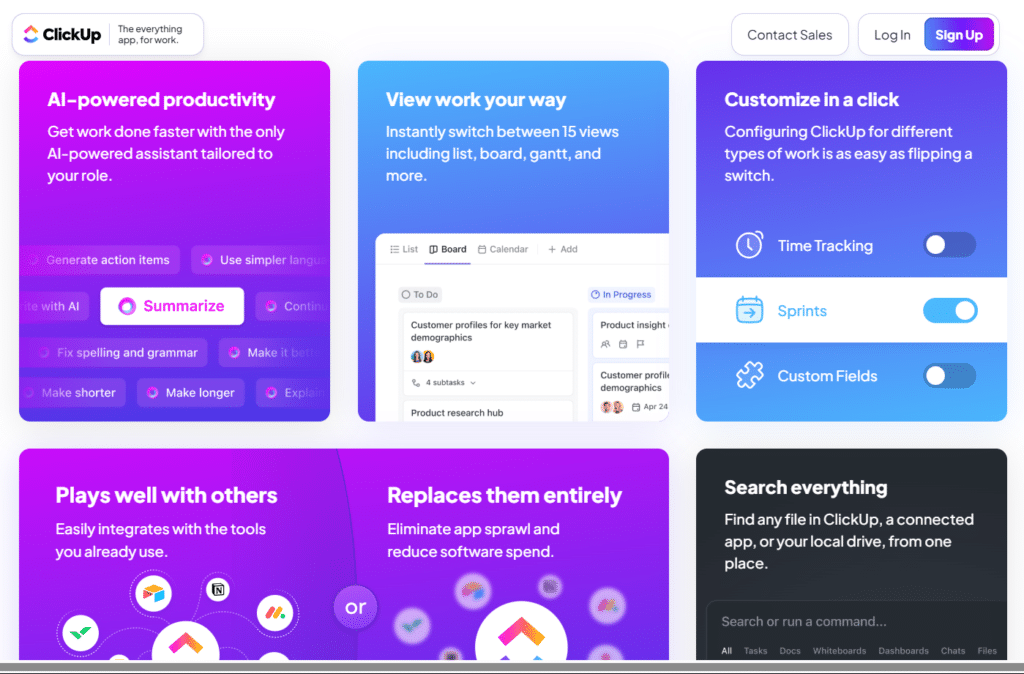
Performance is generally strong, though some users report occasional syncing delays with large projects.
Customization Options
Monday.com Customization
Monday.com allows good customization through:
- Custom fields and column types
- Status labels and colors
- Board templates for different use cases
- Custom dashboards
The platform strikes a balance between flexibility and simplicity. Most teams can adapt it to their needs without extensive configuration.
However, customization exists primarily at the board level. Creating truly custom workflows across the entire platform can be challenging.
ClickUp Customization
ClickUp offers deeper customization options:
- Custom fields with more data types
- Custom statuses for each project
- Conditional formatting
- Custom views and filters
- Custom roles and permissions
The platform’s “Hierarchy” structure (Workspaces > Spaces > Folders > Lists > Tasks) allows for highly tailored setups. Different departments can operate with completely different workflows within the same system.
This flexibility makes ClickUp more adaptable to specialized processes, though it requires more initial setup time.
Security & Compliance
Monday.com Security
Monday.com provides industry-standard security features:
- SOC 2 Type II compliance
- GDPR compliance
- 2FA authentication
- Single Sign-On (Enterprise plan)
- Granular permissions
The platform encrypts data in transit and at rest. Higher-tier plans include audit logs and advanced security controls.
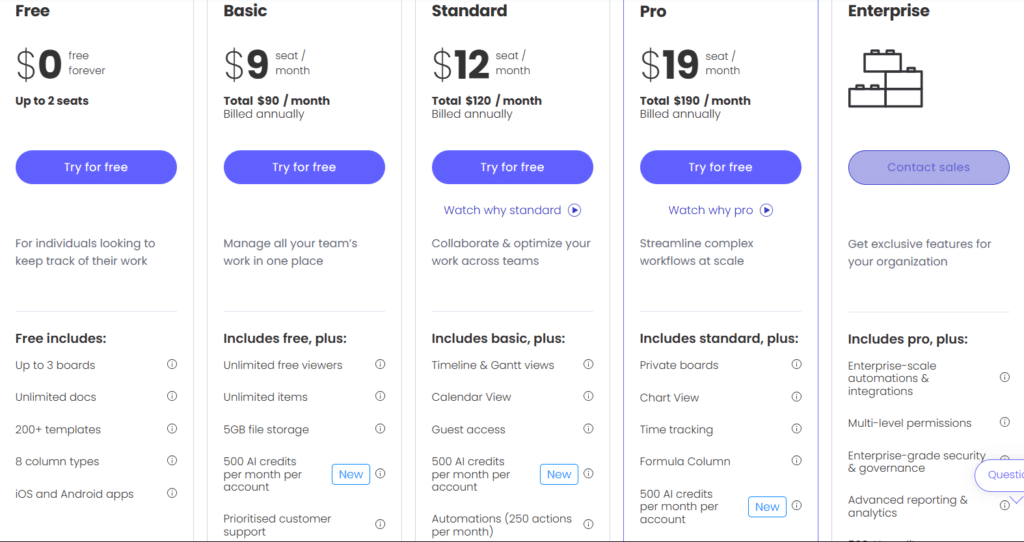
ClickUp Security
ClickUp matches Monday.com’s security credentials while adding:
- HIPAA compliance (Enterprise plan)
- 2FA on all plans
- Customizable permission schemes
- Advanced authentication options
Both platforms take security seriously and meet the requirements of most business users. For highly regulated industries, ClickUp’s HIPAA compliance may be an important differentiator.
Customer Support & Resources
Monday.com Support
Monday.com provides:
- 24/7 email support
- Live chat support (Standard plan and above)
- Phone support (Enterprise only)
- Knowledge base and tutorial videos
- Community forum
Response times are generally good, with users reporting helpful support staff. The knowledge base includes extensive documentation, though finding specific answers sometimes requires digging.
ClickUp Support
ClickUp offers:
- 24/7 email support on all paid plans
- Live chat support
- Priority support (Business plan and above)
- Extensive knowledge base with interactive tutorials
- Active user community
Many users highlight ClickUp’s responsive support team as a strength. The platform also provides more self-service learning resources, including ClickUp University with certification programs.
Use Cases: Who Should Choose Each Tool?
Best Use Cases for Monday.com
Monday.com works best for:
- Teams prioritizing visual workflow management
- Organizations with less technical users
- Marketing and creative teams tracking campaigns
- Small to mid-sized businesses with straightforward project needs
- Teams needing a solution with minimal training time
The platform’s strengths in visual management and ease of use make it ideal for teams that need quick implementation without extensive customization.
Best Use Cases for ClickUp
ClickUp is the better choice for:
- Organizations managing complex projects with dependencies
- Teams needing advanced automation capabilities
- Companies requiring extensive customization
- Software development teams with agile workflows
- Businesses looking to consolidate multiple tools into one platform
ClickUp’s comprehensive feature set makes it suitable for organizations with diverse workflow needs across different departments.
FAQ: Common Questions About Monday.com vs ClickUp
Q: Can I migrate data from Monday.com to ClickUp or vice versa?
A: Yes, both platforms offer import tools. ClickUp has a specific Monday.com importer that transfers boards, tasks, and most attributes. Full migration requires planning, especially for complex setups.
Q: Which platform is better for software development teams?
A: ClickUp has stronger features for development workflows, including sprint planning, code review tracking, and GitHub integration. Its task dependencies and subtask management also work better for complex development projects.
Q: Does either platform work well for non-project tasks like CRM?
A: Both can function as lightweight CRM systems. Monday.com offers CRM-specific templates, while ClickUp provides more customization options for creating a tailored CRM process.
Q: How do the free plans compare?
A: ClickUp’s free plan is significantly more generous, offering unlimited users and tasks with some feature limitations. Monday.com’s free plan is restricted to 2 users and basic functionality.
Q: Can I use either tool for resource management?
A: Both offer workload views, but ClickUp provides more advanced resource management, including capacity planning and resource allocation across projects.
Making Your Final Decision
When choosing between Monday.com and ClickUp, consider these key decision factors:
- Budget constraints – ClickUp offers more features at lower price points
- Team technical expertise – Monday.com has a gentler learning curve
- Project complexity – ClickUp handles complex projects more effectively
- Customization needs – ClickUp provides more tailoring options
- Integration requirements – ClickUp offers more connections to other tools
For most teams, ClickUp represents the better value. Its comprehensive feature set, superior automation capabilities, and lower price make it the clear productivity winner. However, teams prioritizing quick adoption and visual simplicity may still prefer Monday.com.
The good news is that both platforms offer free trials, allowing you to test their capabilities with your specific workflows before committing to a paid plan.
Which project management tool are you currently using? Have you tried either Monday.com or ClickUp? Share your experiences in the comments below!

